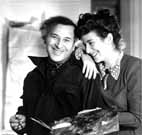
|
|
|

|

|

|

|
|
Click on an image to see a larger, more detailed picture.
|
|
|
|
|
| 1942: The "Final Solution" |

|
pg. 383 |

|
|
|
|
| |
 These Jewish women and children, carefully guarded by Germans, board a train bound for the Treblinka death camp. They were among the 10,000 Jews from Miedzyrzec Podlaski deported to Treblinka during October 1942, a month that was among the bloodiest in the camp's history. Many of Miedzyrzec Podlaski's Jews died on the horrific train ride to Treblinka, rather than in the camp's gas chambers.
These Jewish women and children, carefully guarded by Germans, board a train bound for the Treblinka death camp. They were among the 10,000 Jews from Miedzyrzec Podlaski deported to Treblinka during October 1942, a month that was among the bloodiest in the camp's history. Many of Miedzyrzec Podlaski's Jews died on the horrific train ride to Treblinka, rather than in the camp's gas chambers.
Photo: Main Commission for the Investigation of Nazi War Crimes / United States Holocaust Memorial Museum Photo Archive
|
 Rescued from Occupied France by Varian Fry, painter Marc Chagall, pictured here with his daughter, Ida, was among those modern artists whose work was condemned by the Nazis. When the Nazis gained power, Chagall's works were removed from museums and some were held up for censure in the enormous exhibit of "degenerate art" that was held in Munich in 1937. The Nazis considered Chagall's works, as well as those by Picasso and van Gogh, inappropriate for German collections.
Rescued from Occupied France by Varian Fry, painter Marc Chagall, pictured here with his daughter, Ida, was among those modern artists whose work was condemned by the Nazis. When the Nazis gained power, Chagall's works were removed from museums and some were held up for censure in the enormous exhibit of "degenerate art" that was held in Munich in 1937. The Nazis considered Chagall's works, as well as those by Picasso and van Gogh, inappropriate for German collections.
Photo: University of New Hampshire / United States Holocaust Memorial Museum Photo Archive
|
 Ordnungsdienst
Ordnungsdienst
The Ordnungsdienst (order service) served as the police arm of the Judenrat (Jewish council) in the ghettos. Responsible for carrying out the orders of the council and of the German authorities, the Ordnungsdienst were loathed and feared by the ghetto population--even though they were Jews. Ordnungsdienst personnel faced excruciating moral dilemmas. Initially charged with maintaining discipline in the ghetto, including guarding workers on labor details outside the ghetto, in time the order service was expected to enforce quarantines during typhus outbreaks and carry out deportations. Failure to deliver the mandated number for deportation resulted in harsh repercussions for both the police and ghetto residents. As one Warsaw Ghetto policeman said as he tore a child from the mother's arms: "I have a wife and three children. If I don't deliver my five heads by five o'clock, they'll take my own children. Don't you see? I'm fighting for my own children!"
Photo: Bundesarchiv / United States Holocaust Memorial Museum Photo Archive
|
|

|

|

|

|
 October 29, 1942: In Warsaw, resistance fighters with the Jewish Fighting Organization assassinate Jacob Lejkin, acting commander of the Warsaw Ghetto Jewish police, for his complicity in deportations of Jews.
October 29, 1942: In Warsaw, resistance fighters with the Jewish Fighting Organization assassinate Jacob Lejkin, acting commander of the Warsaw Ghetto Jewish police, for his complicity in deportations of Jews.
|
 October 29, 1942: 3230 thousand Jews from Sandomierz, Poland, are murdered at the Belzec extermination camp.
October 29, 1942: 3230 thousand Jews from Sandomierz, Poland, are murdered at the Belzec extermination camp.
|
 October 29-November 1, 1942: Nearly all of the Jews of Pinsk, Poland, are murdered.
October 29-November 1, 1942: Nearly all of the Jews of Pinsk, Poland, are murdered.
|
 Late October 1942: Local peasants betray six members of the Jewish Fighting Organization near Kraków, Poland, alerting German troops to the Jews' presence.
Late October 1942: Local peasants betray six members of the Jewish Fighting Organization near Kraków, Poland, alerting German troops to the Jews' presence.
|
 Late October 1942: Three thousand Jews readied for deportation from eastern Poland to the Belzec death camp are stripped naked to prevent resistance.
Late October 1942: Three thousand Jews readied for deportation from eastern Poland to the Belzec death camp are stripped naked to prevent resistance.
|
 November 1942: Deportations of Jews from Holland and France continue. One thousand Jews are deported to Auschwitz from the Drancy, France, transit camp. Nearly 5200 are deported there from the Netherlands.
November 1942: Deportations of Jews from Holland and France continue. One thousand Jews are deported to Auschwitz from the Drancy, France, transit camp. Nearly 5200 are deported there from the Netherlands.
|
|
|
|
|
| 1942: The "Final Solution" |

|
pg. 383 |

|
|
The Holocaust Chronicle
© 2009 Publications International, Ltd.
|
|
